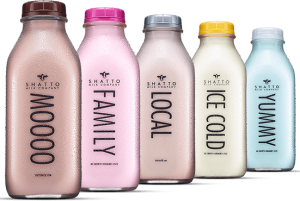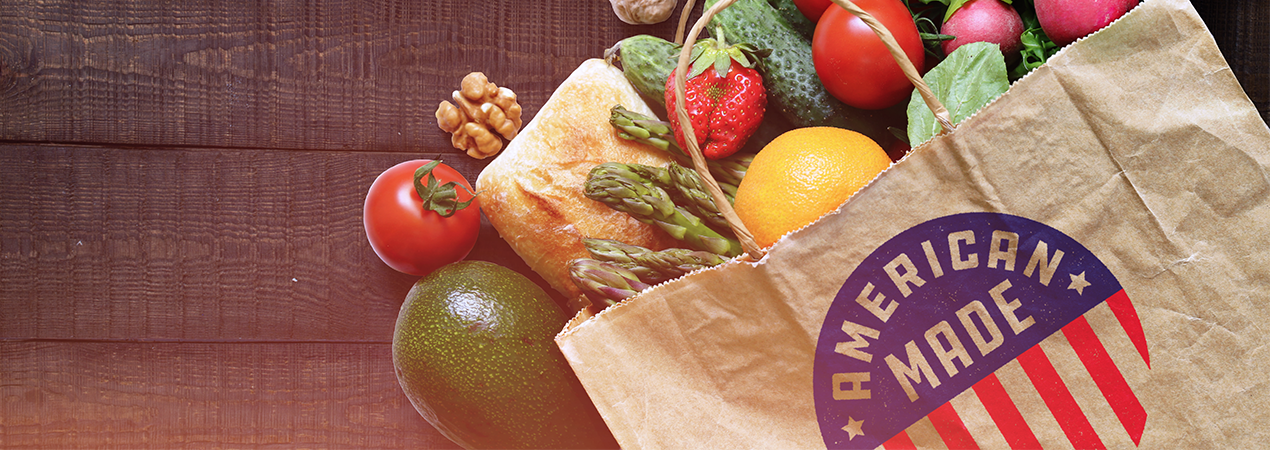According to FoodThink research, 60 percent of American consumers say it’s important that their food is produced in the U.S.1 As families gathered this week to celebrate the Fourth of July, it seemed only fitting for Signal Theory FoodThink to take a look at what might be driving that buying-American trend in the grocery right now, and what CPG brands can do to ensure they are making the most of their consumers’ love of the red, white and blue.
1. Buying American Means Fresher Freshness
69 percent of consumers say buying fresh is extremely or very important when buying groceries, making it one of the most important factors when consumers are selecting food.2 It’s natural to assume that American-grown food that has logged fewer food miles and made it to the plate shortly after it’s been harvested is fresher than its imported counterparts. CPG brands should consider how they can leverage their American-grown or American-raised qualities into freshness claims in their marketing communications with consumers and how they can work with retailers to call these out in-store.

As an example, Green Giant provides step-by-step detail on their website about the process their “100 percent U.S.-grown” corn goes through. They even call out that most of their corn is packed out of Minnesota with the remainder being from the Pacific Northwest. Even though this isn’t a brand that hinges its entire identity on being American, calling out these details helps support perceptions of the freshness of their produce, which is statistically very important to today’s consumers.
2. Buying American Ties Into the Trend of Buying Local
70 percent of consumers say they would like to buy more local food.2 “Local” means different things to different people. To some, it means a farm in their hometown while to others it means a CPG brand with headquarters close to where they live. Some people consider something to be local, as long as it’s made within the United States. Whatever the definition, supporting a community brings with it a feel-good factor, and investing in local lives and the local economy is a big driver for buying American. Local food’s journey from farm-to-fork is also easier to trace, so it inherently brings with it more transparency than foreign imports. American-made CPG brands have a huge opportunity here to instill greater consumer trust in food by highlighting their products’ country, state or even farm of origin.
For example, Missouri-based Shatto Milk Company, a client of Signal Theory, has built a strong brand centered on its locally produced milk delivered fresh to the store within 24 hours of production, in old-fashioned glass bottles. As their agency partner, we’ve been able to help them build their cult following by consistently telling their local story. Shatto has turned their family dairy into a thriving agritourism business, providing tours of its working dairy farm five days a week. They also offer a home delivery service, employing local milk delivery people to provide their own brands and products from dozens of local brands. All of these local aspects give the brand a certain nostalgic Americana feel that resonates with consumers.

3. Buying American Delivers on a Desire for Transparency
Only 34 percent of consumers think food companies are transparent about how food is produced.2 There is a hope and expectation that transparency is easier to come by when buying American products. Brands should show consumers they have nothing to hide by using simple measures such as on-pack claims that consumers can easily research and verify, should they wish to do so, and by giving them a peek behind the curtain to their processes.

Investment in technology could also be the answer for many food producers and CPG brands. Take technology from companies like Harvest Mark, for example, which puts information about fresh food at consumers’ fingertips. Consumers can enter an on-pack code and the Harvest Mark website can tell them exactly where each product was produced, as well as advise them of any food-safety issues, nutritional info, consumer feedback and more.
4. Buying American Can Reflect an Alignment of Values
According to FoodThink research, 65 percent of consumers think it’s important to know how their food is produced.2 This thirst for information extends beyond ingredients and factory processes. More than ever, consumers are secure in their own values and want to invest in brands that share them. Food brands need to be prepared to define and share their position on things such as animal welfare, employee wellness, sustainability and environmental commitments, use of ingredients such as GMOs, and even societal and political change. Consumers want to know that the people producing their food care about more than just making money. Brands who can confidently demonstrate a set of values that benefits all of America stand a much stronger chance of consumers engaging with them. The easiest place to start is by sharing your story on your own website. List your set of values for consumers to see. Eventually, social commentary and cause marketing may form part of your marketing strategy. At the very least, find a cause, define your positions and don’t keep them to yourself.
There are numerous brands we could call out here, but check out California-based Clif Bar & Company. Forthright about what’s important to them, which is so much more than great products, visitors to their website are left with no doubt about what they are supporting when they support this brand. From equal pay for women to climate change, sustainability and community volunteering, Clif Bar undeniably shows that they care about America and are leading the charge in ensuring that corporate social responsibility is more than just a checkbox exercise.
5. Buying American Communicates that Food Can Be Trusted Because it’s Regulated
60 percent of consumers believe that U.S. government regulation makes food safer2 and according to a report from Statista, 52 percent say imported foods are less safe than foods grown and produced in the U.S.3 With imported food breeding less trust, it’s no great surprise that consumers prefer to buy American-made and endorsed.
Highlighting official certifications and accreditations on-pack and in-store is a great way to remind consumers that they are making a safe choice when buying American. In fact, not highlighting them could mean missed opportunities.
Are you missing an opportunity?
The more of these things that CPG brands can talk about, the better. But most important is not to miss out on opportunities by being shy about them. If freshness comes as standard to your product, don’t expect consumers to know that. If you have an amazing set of values that all your employees know about but your consumers don’t, get them published. And if you’re not using those seals your products are eligible for, get them on-pack now.
But what if a brand isn’t American-made or owned?
Many food brands sold in the U.S. today are not solely produced here, and there is a trend toward many once local U.S. brands now being foreign-owned. So are these “non-American” brands at a disadvantage when it comes to connecting with today’s consumers who are looking for fresh, local, transparent, trustworthy brands? The success of some of America’s best-loved foreign brands would indicate not. Many internationally owned brands have still managed to do very well in the U.S.

Among them is California-native Trader Joe’s, which has been German-owned for almost four decades. Regardless of their ownership, they have managed to deliver on fresh, local ingredients and connect with their community in a meaningful way.
Regardless of where a brand is based or a product is made, CPG brands can still inspire loyalty in U.S. consumers by focusing their communications on freshness, local pride, values, regulation, and perhaps most important, transparency. Tie your marketing back to these efforts to highlight how your food is produced and regulated. Talk about community efforts your brand participates in to support where it is grown. What freshness claims and guarantees can you make? And what can you truthfully share with consumers about your company values? In short, shout about what you can where you can, and they will appreciate the honesty.
For more insights that can help CPG brands connect to their audience, visit the Signal Theory FoodThink library of free white papers.
Sources
- Signal Theory FoodThink 2014
- Signal Theory FoodThink 2016
- Statista 2014
- Food Production
Filed Under



